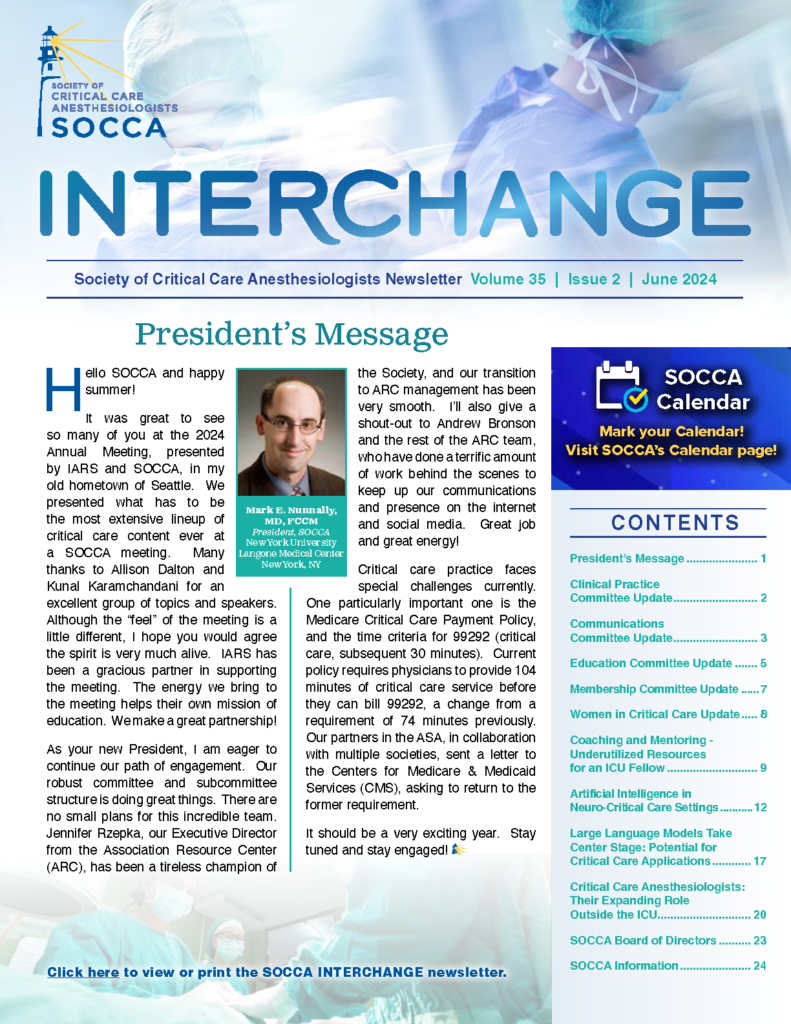Transplant Anesthesiology – Then and Now
Introduction
The field of transplant surgery, with its roots traced back to the pioneering work of Sushruta in 600 BC, has undergone a remarkable evolution. On behalf of the SOCCA-SATA Work Group, this review focuses on transplant anesthesiology, a field of medicine that has played a pivotal role in transforming transplantation into a life-extending therapy for patients with end-organ failure. Advances in multidisciplinary collaboration and research have improved surgical success and patient outcomes.
Historical Overview
From its nascent stages in the 1960s, marked by high mortality rates, the journey of liver transplantation has been characterized by groundbreaking research and development. This progress has allowed for the performance of ever-increasing numbers of transplant surgeries. In 1980, about 30 liver transplantations were performed; by 2021, this number soared to 9,234 1. The survival rate, once below 20% in the 1970s, exceeded 85% by 2013, highlighting the significant strides made in multiple fields of science, technology, and medicine. Advancements in surgical techniques and medicine have incrementally improved patient outcomes. Transformative growth in transplant surgery is predominantly credited to breakthroughs in immunology, pharmacology, and chemistry during the 1970s and 1980s2.This era’s innovations built upon foundational concepts like “self” versus “non-self,” introduced by Peter Medawar during World War II through his pioneering work on skin grafts. Medawar’s observations that allografts were often rejected within two weeks laid the groundwork for the modern era of immunosuppression, which began in 1972 with the introduction of cyclosporine. This development enhanced graft longevity and improved one-year survival rates to over 50% 3,4.
The evolution of transplant surgery has been paralleled by significant strides in transplant anesthesiology, emphasizing the necessity for specialized care teams. Dr. Thomas Starzl and Dr. Jorge Antonio Aldrete’s pioneering contributions highlighted anesthesiology’s critical role in managing these complicated patients during complex transplant surgeries. By the 1980s, dedicated transplant anesthesiology teams were established in some large centers like Pittsburgh. With their experience, these teams significantly improved intraoperative blood product transfusion rates, postoperative need for intensive care, and duration of postoperative ventilation 5.
As the field progressed, the management of the physiological changes in patients with end-stage liver disease during transplantation evolved. Compared to those described by Aldrete et al. (1969)6, early practices have given way to more sophisticated techniques and technologies. These advancements include the shift from arterial cutdowns to the Seldinger technique for radial artery cannulation and the preference for transesophageal echocardiography (TEE) over pulmonary artery catheter (PAC) placement, reflecting broader trends in managing cardiovascular risks 2,3.
Current State and Future Directions
Today, the approach to transplantation is more nuanced, focusing on blood conservation, precise glucose control, and the use of advanced warming technologies to optimize patient outcomes. As outcomes improve, we can perform these surgeries on higher-risk patients. This calculated but increased risk-taking approach has led to an expanding recipient pool, but organ scarcity remains a significant barrier to transplantation. Necessity leads to innovation, and there has been dedicated work from the clinical and technology side in developing extended donor criteria and mechanical perfusion technologies.
The progress we have seen over the past 60 years would not have been possible without the medical societies that have been established to help disseminate new ideas and develop solutions to common problems. The first in the United States was the International Liver Transplantation Society, established in 1974, which now hosts annual meetings in collaboration with the Society for the Advancement of Transplant Anesthesia (SATA, established in 2016). These societies are open to all and provide a forum to help maintain a high standard of care through research and education. Society of Critical Care Anesthesiologists (SOCCA) has been a recent addition to the group of organizations helping support the growth of transplant anesthesiology with a unique focus on critical care. SOCCA has developed a joint SOCCA-SATA work group to address the overlap in these specialties. The works group’s current projects include developing guidelines on donor optimization and a robust resident/fellow curriculum on managing patients with liver disease undergoing nontransplant surgery. As transplant numbers grow and new programs open, there is an ongoing need for experts who care for patients throughout the perioperative spectrum. We firmly believe that the collaboration between SOCCA and SATA will bring intensivists and transplant anesthesiologists together with the shared goal of improving patient outcomes. This relationship will provide a forum for ideas and sustainable growth of our specialties and solidify our identity as perioperative consultants in the field of transplantation.
References:
- Kwong AJ, Ebel NH, Kim WR, et al. OPTN/SRTR 2021 Annual Data Report: Liver. AmTransplant. 2023;23(2 Suppl 1):S178-S263.
- Valentine E, Gregorits M, Gutsche JT, Al-Ghofaily L, Augoustides JG. Clinical update in liver transplantation. J Cardiothorac Vasc Anesth. 2013;27(4):809-815.
- Sharma S, Saner FH, Bezinover D. A brief history of liver transplantation and transplant anesthesia. BMC Anesthesiol. 2022;22(1):363. Published 2022 Nov 26.
- Starzl TE, Iwatsuki S, Van Thiel DH, et al. Evolution of liver transplantation. Hepatology. 1982;2(5):614-636.
- Hevesi ZG, Lopukhin SY, Mezrich JD, Andrei AC, Lee M. Designated liver transplant anesthesia team reduces blood transfusion, need for mechanical ventilation, and duration of intensive care. Liver Transpl. 2009;15(5):460-465.
- Aldrete JA, LeVine DS, Gingrich TF. Experience in anesthesia for liver transplantati. Anesth Analg. 1969;48(5):802-814.
- Cameron AM. Pumping Livers: Two Trials, Many Questions. Ann Surg. 2023;278(5):e930-e931.
- Carton EG, Plevak DJ, Kranner PW, Rettke SR, Geiger HJ, Coursin DB. Perioperative care of the liver transplant patient: Part 2. Anesth Analg. 1994;78(2):382-399.



































